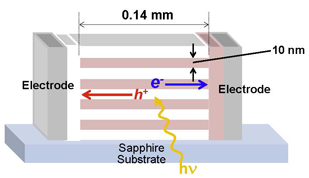Bulkheterojunctions (blended junctions) are indispensable for organic solar cells. However, the fabrication of electron and hole transport routes in bulkheterojunction remains quite challenging. Here, a lateral alternating multilayered junction having an ability to collect both excitons and carriers almost completely, which can be regarded as an alternative bulkheterojunction, is successfully demonstrated. The present new concept paves the way to exceed the conversion efficiency of organic solar cells above 20%.
Conversion efficiency of organic solar cells have been increased steadily after the invention of bulkheterojunction (blended junction) by research group in 1991. Nowadays, the bulkheterojunction is indispensable for organic solar cells. However, a key factor to obtain the high efficiency, namely, the fabrication of electron and hole transport routes in blended cells remains quite challenging.
A vertical alternating multilayered structure having designed vertical routes is an ideal structure, which is equivalent to the structure shown in Figure rotated 90º. However, since the required aspect ratio reaches 100, the designated fabrication of such structures when using current lithography techniques is still very difficult.
Research group had an idea that if carrier transport over a long distance parallel to the substrate is possible, the formation of a vertical route is unnecessary.
Research group at Institute for Molecular Science proposed a novel concept of the structure of organic solar cell, namely, a lateral alternating multilayered junction (Figure). An essential point is that the photogenerated holes and electrons are laterally transported and extracted to the respective electrodes.
Minimum units of proposed junction are hole highway and electron highway. At first, research group demonstrated that lateral extraction of photogenerated holes and electrons of the order of 1 mm in the hole and electron highways using ultra-high mobility organic films. Observed macroscopic value of milli-meter order is surprising long compared to the conventional value below 1 µm. Next, research group demonstrated the successful operation of organic solar cell having a lateral alternating multilayered junction by combining the hole highway and electron highway. A total of 93% of the photogenerated electrons and holes are laterally collected over a surprising long distance (0.14 mm). The exciton-collection efficiency reaches 75% in a lateral alternating multilayered junction with a layer thickness of 10 nm. Therefore, the lateral junction is proved to have an ability to collect both excitons and carriers almost completely.
A lateral alternating multilayered junction can be regarded to be an alternative bulkheterojunction for organic solar cells. Advantage of a lateral cell is its unlimited thickness in the vertical direction. Therefore, tandem solar cells that can utilize the full solar spectrum can be freely designed. The present new concept paves the way to exceed the conversion efficiency of organic solar cells above 20%.

Lateral junction
A lateral organic alternating multilayered junction can be an alternative bulkheterojunction for organic solar cells.
Information of the paper
Mitsuru Kikuchi, Masaki Hirota, Thidarat Kunawong, Yusuke Shinmura, Masahiro Abe, Yuichi Sadamitsu, Aye Myint Moh, Seiichiro Izawa, Masanobu Izaki, Hiroyoshi Naito, and Masahiro Hiramoto
ACS Applied Energy Materials
“Lateral Alternating Donor/Acceptor Multilayered Junction for Organic Solar Cells” DOI:10.1021/acsaem.8b02135
Research Group
Institute for Molecular Science, 5-1 Higashiyama, Myodaiji, Okazaki 444-8787, Aichi, Japan, Nippon Kayaku Co., Ltd., 31-12 Shimo 3-Chome, Kita-ku, Tokyo 115-8588, Japan,
Toyohashi University of Technology, 1-1 Hibarigaoka, Tenpaku, Toyohashi, Aichi 441-8580, Japan,
Osaka Prefecture University, 1-1 Gakuen, Naka-ku, Sakai, Osaka 599-8531, Japan, Mahidol University, 272 Rama VI Road, Ratchathewi, Bangkok 10400, Thailand,
New Energy and Industrial Technology Development Organization (NEDO), 1310 Omiya,
Saiwai-ku, Kawasaki, Kanagawa 212-8554, Japan,
Financial Supports
JSPS, KAKENHI (No.17K19110)
NEDO, Advanced Research Program for Energy and Environmental Technologies
Contact
Masahiro Hiramoto (Professor), Institute for Molecular Science, Natural Institutes of Natural Sciences
TEL: +81-564-59-5537
FAX: +81-564-59-5537
E-mail: hiramoto_at_ims.ac.jp (Please replace the "_at_" with @)
Press contact
Public Relations, Research Enhancement Strategy Office,
Institute for Molecular Science, Natural Institutes of Natural Sciences
TEL: +81-564-55-7209
FAX: +81-564-55-7374
E-mail: press_at_ims.ac.jp (Please replace the "_at_" with @)
1116

